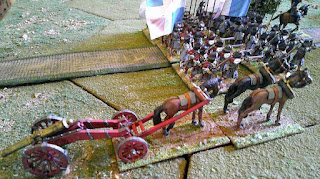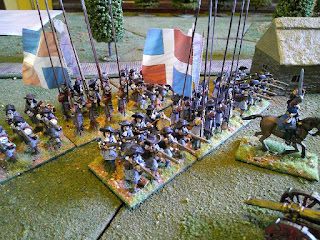Today being the anniversary of the Battle of Seneffe in 1674 and the weather being too hot to be outside, I decided to have a Sun King game in the cool of the dining room. Most battles of the 1672-1678 war had a lot of cavalry in relationship to infantry, with cavalry acting as a decisive arm. However, for a change, I thought I would fight a battle where infantry had a bigger role, so I looked around for a battle from a later period and put together a scenario. The result, somewhat disguised from the original (can you guess what battle it was?), was the Battle of Kruispuntdorp, which takes place somewhere in the Low Countries in 1674.
In this game, the Allied forces began with a small rearguard of dragoons and infantry, covering the retreat of their main body. The French, in pursuit, have a mixed force in infantry and cavalry, the latter including some elite units. Their task is to beat the rearguard and any reinforcements which come to its aid. As the action progresses, more Allied units arrive on the table, these being mainly infantry, returning to support the rearguard and hold a line against the French. The latter get some reinforcements, but by late in the game the Allies have an advantage of numbers.
The game was played lengthways on a six feet by four feet table (180cm by 120cm). The French (including reinforcements) had six infantry regiments, two artillery batteries and four cavalry regiments, plus three Guard cavalry squadrons. The Allies (including reinforcements) had two dragoon regiments, nine infantry regiments, two artillery batteries and two cavalry regiments. The game was set for 20 turns and I used my own rules.
I also devised a set of random events, with a d6 rolled at the start of each turn, an event occurring on a '6'. I did not want them to get in the way of the battle, but just to add an element of the unexpected. In the event, only one random event occurred - an Allied supply wagon entering the table and making its way across the battlefield.
Here are the photographs.
The Allied rearguard - two dragoon regiments, a light artillery battery and one infantry regiment.
Erbprinz Dragoon Regiment (Hesse-Kassel).
Trautmannsdorff Dragoon Regiment (Austria).
Brandenburg Foot Regiment (United Provinces).
The Allied light artillery battery.
The French enter the table.
Normandie and Royal Foot Regiments and a light artillery battery.
Riyal Cravattes Horse Regiment (two squadrons).
Picardie Foot Regiment (two battalions) and Foix Horse Regiment (two squadrons).
The French complete their arrival - Maison du Roi (three squadrons: from right to left, Gensdarmes, Chevau-Légèrs and Mousquetaires) and Cuirassiers du Roi Horse Regiment (two squadrons).
Allied reinforcements arrive - Anhalt-Bernburg Foot Regiment (Hesse-Kassel) and Schellaert Horse Regiment (two squadrons) (United Provinces).
More Allied infantry arrives - Schwartsenberg and Beaumont Foot Regiments (United Provinces).
French reinforcements - Condé and Plessis-Praslin Foot Regiments,
along with a medium artillery battery.
More Allied infantry arrive - Aylva and Luttisch Foot Regiments (United Provinces and Liège), together with a medium artillery battery.
Another Allied cavalry unit - Nassau-Friesland Horse Regiment (two squadrons) (United Provinces).
The Allied supply wagon - it got in the way of various units during its journey across the battlefield.
And even more Allied infantry arrives - Nassau-Friesland Foot Regiment and another battalion of Aylva Foot Regiment (United Provinces).
The last of the Allied reinforcements - a battalion of the Gardes te voet Regiment (United Provinces).
The last of the French reinforcements - Mestre-de-camp général Horse Regiment (two squadrons).
The French managed to drive back the rearguard but made little headway against the increasing numbers of Allied infantry that arrived as the game progressed. The large force of French cavalry never really got into the fight, although they did beat the Allied cavalry pretty convincingly. Since the fighting had moved so far down the table by the time they arrived, the French reinforcements did not have any effect by the time the game ended.
Thoughts on the scenario: it worked in the sense of getting a lot of infantry onto the field, but it was on too narrow a front to get them all involved and for the cavalry to play more of a role. I intend to address this by playing the game across the table and with a wider front. The reinforcement schedule worked well, but with a shallower depth next time the French should get their extra troops into action more quickly. The random events did not detract at all from the game, their being only one in 20 turns, so I will keep them.


































































































Interesting fight. Yeah, probably needed a bigger wider table. Oh well, you can always try it again. No lives were lost :)
ReplyDeleteThanks, really enjoyed browsing all those lovely photos. Nice assembly of troops and I have just bought those latex cobbled road sections, so good to see that they butt up nicely to each other.
ReplyDeleteSuper-looking game! You are clearly going to need a bigger table. :-)
ReplyDelete